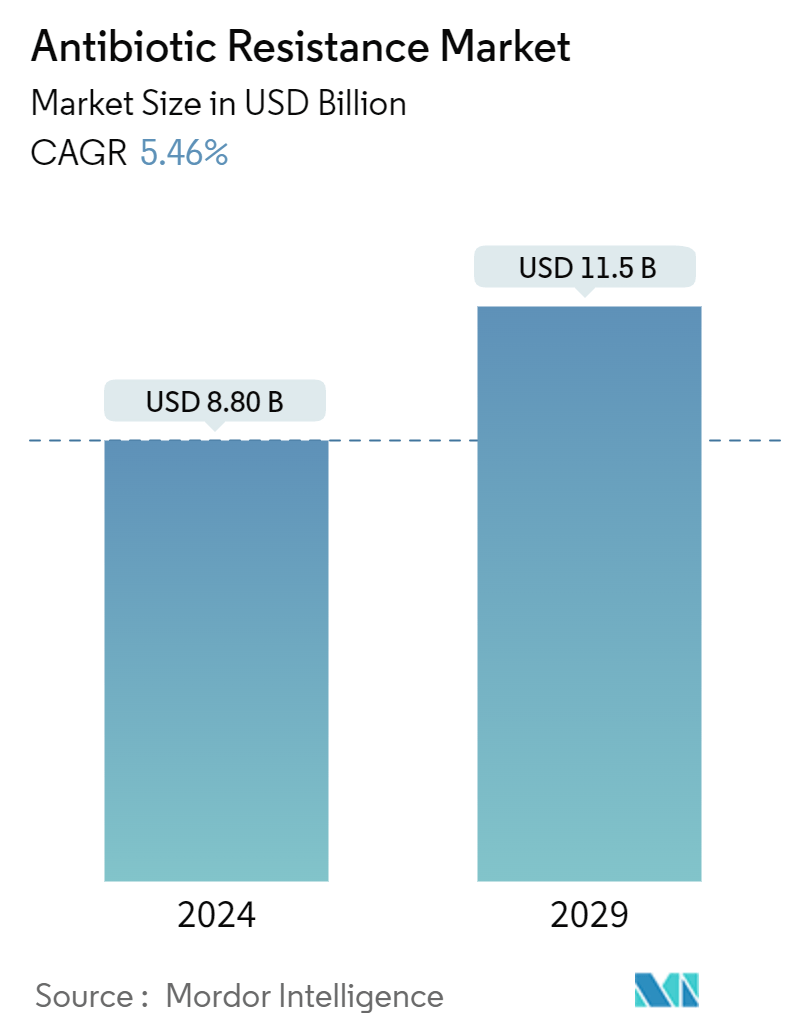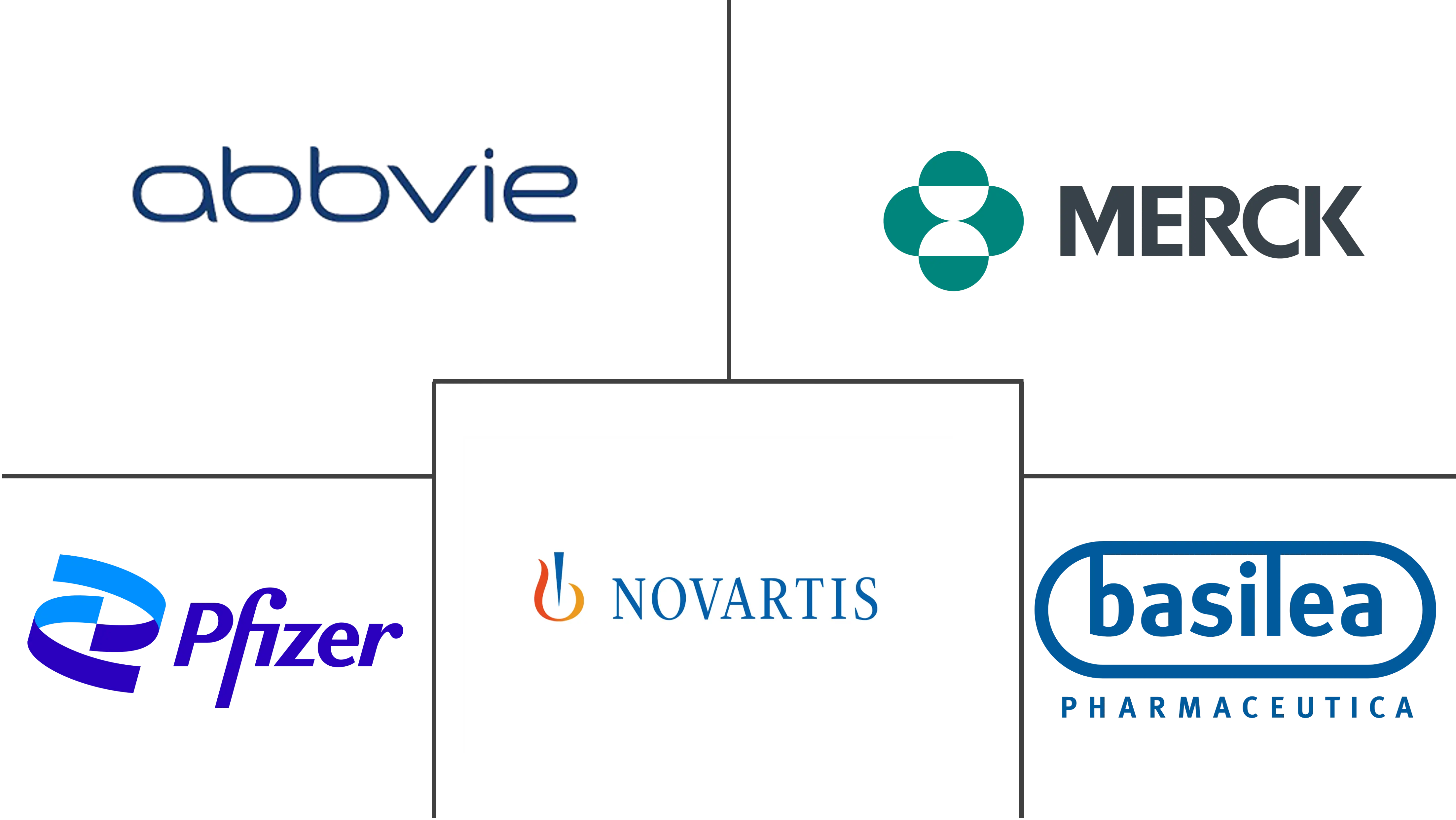Market Size of Antibiotic Resistance Industry

| Study Period | 2019 - 2029 |
| Market Size (2024) | USD 8.80 Billion |
| Market Size (2029) | USD 11.5 Billion |
| CAGR (2024 - 2029) | 5.46 % |
| Fastest Growing Market | Asia Pacific |
| Largest Market | North America |
| Market Concentration | Medium |
Major Players
*Disclaimer: Major Players sorted in no particular order |
Antibiotic Resistance Market Analysis
The Antibiotic Resistance Market size is estimated at USD 8.80 billion in 2024, and is expected to reach USD 11.5 billion by 2029, growing at a CAGR of 5.46% during the forecast period (2024-2029).
The key drivers of the market are the increasing burden of antibiotic-resistant infections across developed and developing regions and a shift in prescription patterns to newly launched therapies.
The increasing involvement of government and non-government bodies in developing novel therapies is anticipated to drive market growth. The high burden of antibiotic-resistant infections is a major concern globally. For instance, according to the CDC's data published in October 2022, more than 2.8 million antimicrobial-resistant infections occur each year in the United States, and more than 35,000 people die as a result of antibiotic resistance.
Moreover, in February 2023, the Australian government raised USD 6 million in funds for research into antimicrobial resistance and reducing the incidence of hospital infections. This grant opportunity was announced as part of the Medical Research Future Fund (MRFF) under the Global Health Initiative. Thus, such government initiatives are expected to boost the market's growth over the forecast period.
Some major companies operating in the AMR are adopting several strategies, such as collaboration and acquisition, along with various launches to strengthen their positions in the market. For instance, in January 2023, Alkem Laboratories launched an antibiotic, Zidavi, for multiple drug-resistant (MDR) infections. Moreover, in January 2023, Molbio Diagnostics launched Truenat MTB-INH to test the presence of isoniazid resistance in Mycobacterium tuberculosis in infection (MDR-TB). The test was validated by ICMR and approved by CDSCO, which can provide sample-to-test results in an hour.
The high burden of antibiotic resistance, the launch of new drugs for antibiotic-resistant infections, and initiatives taken by government are propelling the market growth. However, strict safety guidelines and the high cost of AMR therapeutics are expected to hinder the market's growth.
Antibiotic Resistance Industry Segmentation
As per the scope of the report, antibiotic resistance occurs when bacteria change in response to the use of these medicines. These bacteria may infect humans and animals, and the infections they cause are harder to treat than those caused by non-resistant bacteria.
The antibiotic Resistance market is segmented by disease, pathogen, mechanism of action, drug class, distribution channel, and geography. By disease, the market is sub-segmented into Clostridioides difficile infection (CDI), complicated intra-abdominal infection (cIAI), acute bacterial skin and skin structure infections (ABSSSI), hospital-acquired and ventilator-associated bacterial pneumonias (HABP), complicated urinary tract infection (cUTI), community-acquired pneumonia (CABP), and bloodstream infection (BSI)). By pathogen, the market is sub-segmented into Acinetobacter baumannii, Staphylococcus aureus, Pseudomonas aeruginosa, Haemophilus influenzae, E. coli, and other pathogens. By drug class, the market is sub-segmented into Tetracyclines, Oxazolidinones, Cephalosporins, Lipoglycopeptides, Combination therapies, and other drug classes. By the mechanism of action, the market is sub-segmented into cell wall synthesis inhibitors, protein synthesis inhibitors, DNA synthesis inhibitors, RNA synthesis inhibitors, and others. By distribution channel, the market is sub-segmented into hospital pharmacies, retail pharmacies, and online pharmacies. By geography, the market is sub-segmented into North America, Europe, Asia-Pacific, the Middle East and Africa, and South America. The report also covers the market sizes and forecasts in 17 countries across major regions. For each segment, the market sizing and forecasts were made on the basis of revenue (USD).
| By Disease | |
| Clostridioides Difficile Infection (CDI) | |
| Complicated Intra-Abdominal Infection (cIAI) | |
| Acute Bacterial Skin and Skin Structure Infections (ABSSSI) | |
| Hospital-Acquired and Ventilator-Associated Bacterial Pneumonias (HABP) | |
| Complicated Urinary Tract Infection (cUTI) | |
| Community-Acquired Pneumonia (CABP) | |
| Bloodstream Infection (BSI) |
| By Pathogen | |
| Acinetobacter baumannii | |
| Staphylococcus aureus | |
| Pseudomonas aeruginosa | |
| Haemophilus influenzae | |
| E. Coli | |
| Other Pathogens |
| By Drug Class | |
| Tetracyclines | |
| Oxazolidinones | |
| Cephalosporins | |
| Lipoglycopeptides | |
| Combination therpaies | |
| Other Drug Classes |
| By Mechanism of Action | |
| Cell Wall Synthesis Inhibitors | |
| Protein Synthesis Inhibitors | |
| DNA Synthesis Inhibitors | |
| RNA synthesis inhibitors | |
| Other Mechanisms of Action |
| By Distribution Channel | |
| Hospital Pharmacies | |
| Retail Pharmacies | |
| Online Pharmacies |
| Geography | ||||||||
| ||||||||
| ||||||||
| ||||||||
| ||||||||
|
Antibiotic Resistance Market Size Summary
The antibiotic resistance market is poised for significant growth, driven by the increasing prevalence of antibiotic-resistant infections globally. This surge in resistance is prompting a shift in prescription patterns towards newly launched therapies, which is expected to propel the market forward. Government and non-governmental organizations are actively involved in developing novel therapies, further boosting market expansion. The high burden of antibiotic-resistant infections, such as complicated urinary tract infections, underscores the urgent need for effective treatments, thereby driving demand in the market. The introduction of new drugs and strategic collaborations among major companies are also contributing to the market's dynamic landscape.
North America is anticipated to lead the antibiotic resistance market, fueled by a high population resistant to antibiotics and substantial investment in research and development. The region's growing burden of antibiotic resistance is expected to increase the demand for therapeutic solutions, enhancing market growth. Initiatives like increased funding for antimicrobial resistance projects are further supporting this trend. The market is moderately consolidated, with major players engaging in collaborations to enhance their market presence. As innovation and investment continue to rise, the competitive landscape is expected to intensify, driving further advancements in the antibiotic resistance market.
Antibiotic Resistance Market Size - Table of Contents
-
1. MARKET DYNAMICS
-
1.1 Market Overview
-
1.2 Market Drivers
-
1.2.1 High Burden of Antibiotic Resistant Infections
-
1.2.2 Increase in Global Initiatives Drives New Drug Development
-
-
1.3 Market Restraints
-
1.3.1 Strict Safety Guidelines
-
1.3.2 High Cost of AMR Therapeutics
-
-
1.4 Porter's Five Forces Analysis
-
1.4.1 Bargaining Power of Buyers/Consumers
-
1.4.2 Bargaining Power of Suppliers
-
1.4.3 Threat of New Entrants
-
1.4.4 Threat of Substitute Products
-
1.4.5 Intensity of Competitive Rivalry
-
-
-
2. MARKET SEGMENTATION (Market Size by Value - USD)
-
2.1 By Disease
-
2.1.1 Clostridioides Difficile Infection (CDI)
-
2.1.2 Complicated Intra-Abdominal Infection (cIAI)
-
2.1.3 Acute Bacterial Skin and Skin Structure Infections (ABSSSI)
-
2.1.4 Hospital-Acquired and Ventilator-Associated Bacterial Pneumonias (HABP)
-
2.1.5 Complicated Urinary Tract Infection (cUTI)
-
2.1.6 Community-Acquired Pneumonia (CABP)
-
2.1.7 Bloodstream Infection (BSI)
-
-
2.2 By Pathogen
-
2.2.1 Acinetobacter baumannii
-
2.2.2 Staphylococcus aureus
-
2.2.3 Pseudomonas aeruginosa
-
2.2.4 Haemophilus influenzae
-
2.2.5 E. Coli
-
2.2.6 Other Pathogens
-
-
2.3 By Drug Class
-
2.3.1 Tetracyclines
-
2.3.2 Oxazolidinones
-
2.3.3 Cephalosporins
-
2.3.4 Lipoglycopeptides
-
2.3.5 Combination therpaies
-
2.3.6 Other Drug Classes
-
-
2.4 By Mechanism of Action
-
2.4.1 Cell Wall Synthesis Inhibitors
-
2.4.2 Protein Synthesis Inhibitors
-
2.4.3 DNA Synthesis Inhibitors
-
2.4.4 RNA synthesis inhibitors
-
2.4.5 Other Mechanisms of Action
-
-
2.5 By Distribution Channel
-
2.5.1 Hospital Pharmacies
-
2.5.2 Retail Pharmacies
-
2.5.3 Online Pharmacies
-
-
2.6 Geography
-
2.6.1 North America
-
2.6.1.1 United States
-
2.6.1.2 Canada
-
2.6.1.3 Mexico
-
-
2.6.2 Europe
-
2.6.2.1 Germany
-
2.6.2.2 United Kingdom
-
2.6.2.3 France
-
2.6.2.4 Italy
-
2.6.2.5 Spain
-
2.6.2.6 Rest of Europe
-
-
2.6.3 Asia-Pacific
-
2.6.3.1 China
-
2.6.3.2 Japan
-
2.6.3.3 India
-
2.6.3.4 Australia
-
2.6.3.5 South Korea
-
2.6.3.6 Rest of Asia-Pacific
-
-
2.6.4 Middle East and Africa
-
2.6.4.1 GCC
-
2.6.4.2 South Africa
-
2.6.4.3 Rest of Middle East and Africa
-
-
2.6.5 South America
-
2.6.5.1 Brazil
-
2.6.5.2 Argentina
-
2.6.5.3 Rest of South America
-
-
-
Antibiotic Resistance Market Size FAQs
How big is the Antibiotic Resistance Market?
The Antibiotic Resistance Market size is expected to reach USD 8.80 billion in 2024 and grow at a CAGR of 5.46% to reach USD 11.5 billion by 2029.
What is the current Antibiotic Resistance Market size?
In 2024, the Antibiotic Resistance Market size is expected to reach USD 8.80 billion.

